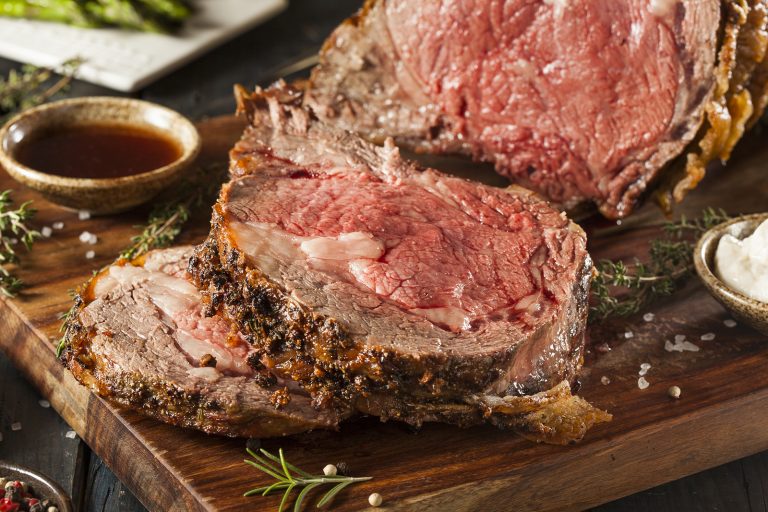April 27th is National Prime Rib Day! If you are anything like us, the mention of prime rib gets your mouth watering.

Prime rib is sometimes known as the “King of Meats” and is a prime beef cut from one of the eight primal cuts of beef. This cut of meat is located between the sixth and twelfth rib, on the upper back of the cattle. Prime rib is often mistaken as a steak, and that is not the case. Prime rib is technically a roast. When you slice the ribs into steaks before cooking, it becomes a rib eye steak.
When you buy prime rib from the butcher be sure to specify that you want the meat to be “prime” quality and not “choice.” Tell them you want it dry-aged and that you would like it to have a lot of marbling. More marbling means more flavor. You can order a partial cut of the prime rib known as the “first cut,” or “loin-end rib roast.” It is leaner with less fat, but is also more expensive. There is also the “second cut,” or “chuck-end rib roast,” which is a bigger section that has more layers of fat, but it’s also cheaper. If you ask the butcher to leave the “fat cap,” a layer of fat on top of the meat, it will protect the rib while cooking and add tremendous flavor.
It is best to cook your prime rib on the bones without the meat touching the pan. Sometimes prime rib is called a “standing roast” because of the way it is cooked. With prime rib you should keep preparation simple, with salt and pepper on the outside, roast it slowly and evenly at 325 degrees for 30 minutes before testing the internal temperature with a meat thermometer. Rare will be 115 degrees, medium-rare is 120 degrees, and medium is 130 degrees. Once done, let it sit for 20 minutes to retain its juices for maximum succulence. Popular sides served with prime rib are a fully loaded baked potato or fries, mushrooms, and onion gravy.
When you order prime rib at a restaurant you should order it medium-rare. Ordering it cooked that way will help the meat retain its juices, which will make it more flavorful and rich. Most restaurants have removed prime rib from their menus because rising wholesale beef prices have made it too expensive to serve as they prepare the entire seven-rib roast. Which would mean anything not served is lost revenue. However you may find it still in some classic steakhouses.
Arizona Legacy Beef and Carlink Ranch are two of Arizona’s ranchers who provide beef to consumers. Arizona Legacy Beef is family owned and dedicated to raising all-natural gourmet beef from the Criollo cattle raised on their ranch. They are located in Central Arizona, south of Dewey-Humboldt. To learn more about their product and to make a purchase you can follow this link. Carlink Ranch is located in Benson, Arizona. Carlink Ranch has been working the land for over 127 years, and specializes in English Cross Beef Cattle and Heifer Development. You can learn more by visiting their webpage. You can find fresh, Arizona grown prime rib close to you on Fill Your Plate by going to “Find a Farm product” and then choosing “beef.”
Because beef is Arizona’s leading agricultural product, annually producing enough beef to feed more than 4.6 million Americans, this is a great holiday to celebrate! There is no better way to celebrate National Prime Rib Day than cooking a thick and juicy prime rib to your liking! We recommend Arizona Rancher’s Prime Rib. Don’t forget the Cabernet and the fully loaded baked potato!
Related articles
- London Broil is Tasty Using Arizona Beef! (fillyourplate.org)
- Arizona Beef has Plenty of Lean Cuts! (fillyourplate.org)
- Marinades and Rubs for Your Beef Recipes: Tips to Better Seasoning (fillyourplate.org)

